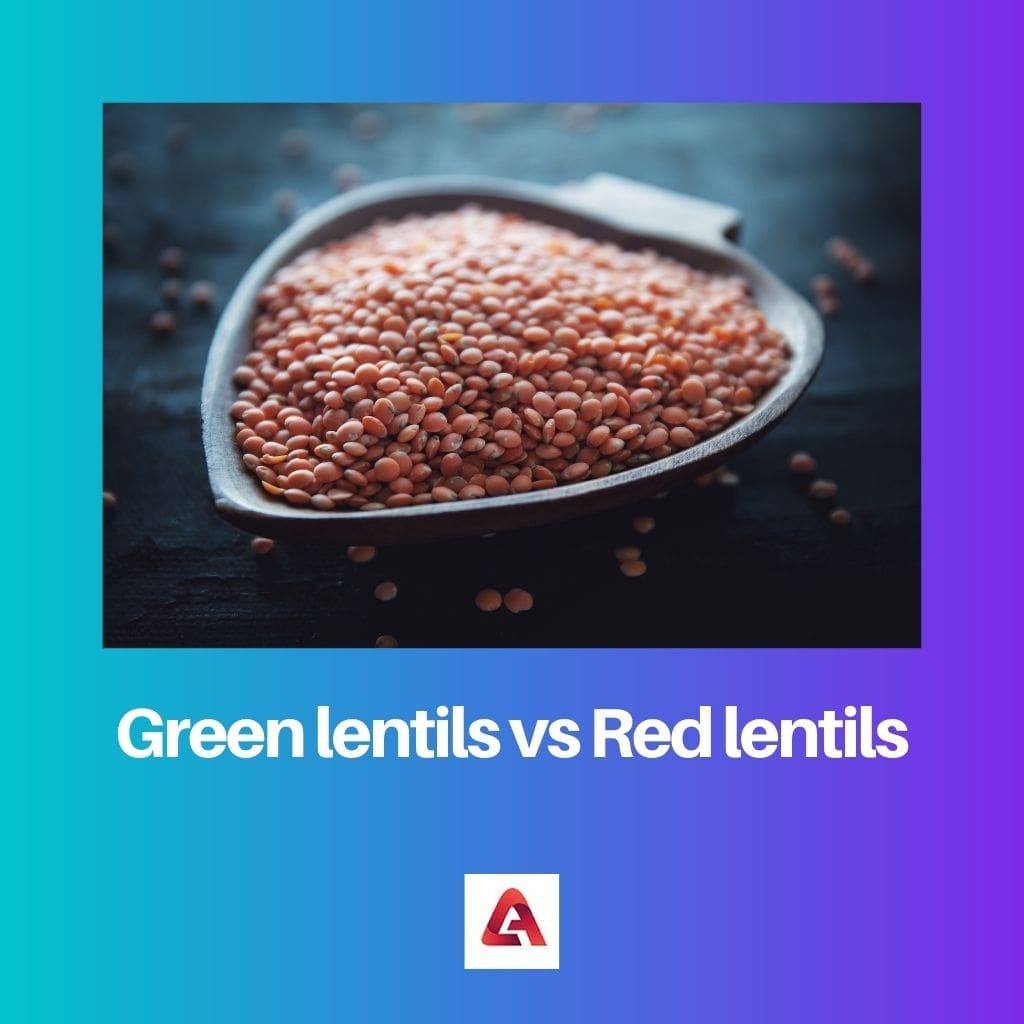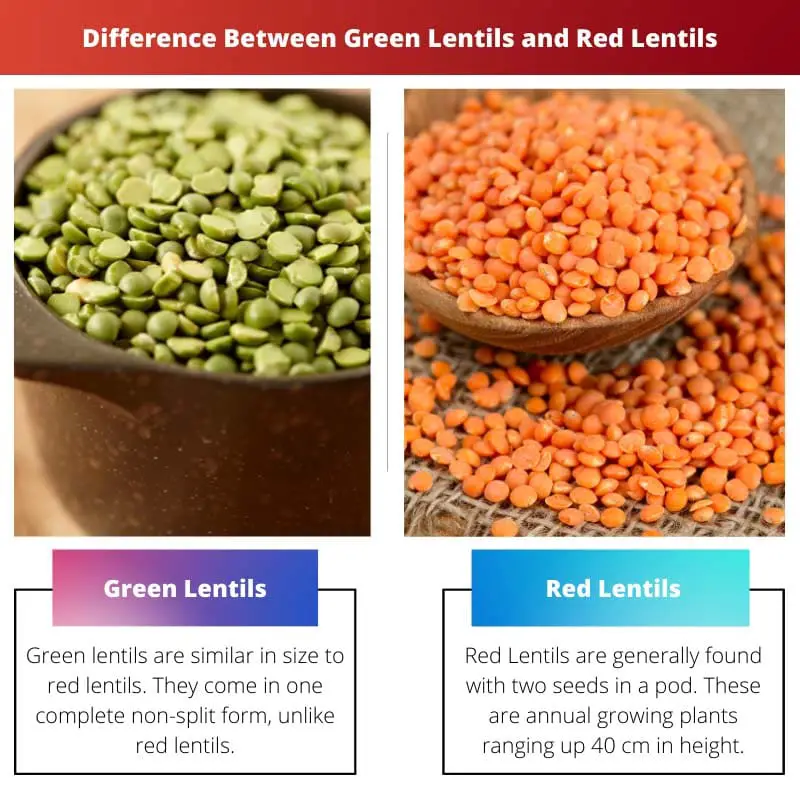Lentils are a significant source of protein for our bodies, also containing a good amount of iron and zinc to nourish our insides. You can consume lentils in various ways, in salads, in stews, soups, dips, etc.
Lentils come in different shapes, sizes and colours. Primarily, they can be differentiated into Green Lentils and Red Lentils.
Key Takeaways
- Green lentils are larger, have a firmer texture, and retain their shape when cooked, making them suitable for salads, side dishes, and recipes that require a substantial texture.
- Red lentils are smaller, have a sweeter, nuttier flavor, and become soft when cooked, making them ideal for soups, stews, and purees.
- Both green and red lentils are nutritious and versatile legumes, but their differences in size, texture, and cooking properties make them suitable for different dishes.
Green Lentils vs Red Lentils
Green and Red lentils differ in their texture, shape and size, cooking method and cost. Where green lentils have only two varieties, red lentils have four. In the table below, you will understand some significant differences between the two lentils.

The green lentils are deep green and have a glossy touch on their surface. Their earthy flavour is somewhat stronger than brown lentils.
They are costlier compared to other varieties of lentils. Green lentils have two sub-categories: The French Green Variety and Lentilles du Puy.
The red lentils are sometimes also called brown or orange lentils due to the variation in colour depending upon the soil they grow in. Red lentils are rare, and they are only found growing in the Middle East and India. In India, they are commonly known as “masoor dal”.
The red lentils come in various colours, such as Crimson, Red Chief, Petite Golden and Canary gold. Although both lentils (green and red) are rich in protein and have similarities in their origin, there are certainly some significant differences separating them.
Comparison Table
| Parameters of Comparison | Green Lentils | Red Lentils |
|---|---|---|
| Shape and Texture | Green lentils are whole non-split lentils with one covering. The covering is glossy in appearance. | Red Lentils are split in two and do not have any covering. They have a matte-like powdery outer texture. |
| Varieties | Green lentils come in two sub-categories: The French Green Variety and Lentilles du Puy. | Red lentils come in four notable varieties: Crimson, Red Chief, Petite Golden and Canary gold. |
| Cooking time | Green lentils take a good time to cook properly. | Red lentils, on the other hand, take comparatively less time to cook. |
| Flavour | Green lentils have a peppery flavour to them post-cooking. They tend to retain their shape even after being cooked. | Red lentils have a nutty flavour and dissolve entirely or partially after cooking. |
| Cost | Green lentils are costlier than red lentils. | Red lentils are cheaper than green lentils. |
What is Green Lentils?
Green lentils are similar in size to red lentils. They come in one complete non-split form, unlike red lentils.
They have one outer covering, which is glossy in appearance. After cooking, these lentils retain shape and do not deform or dissolve like red ones.
Due to their compactness and earthly texture, these lentils take time to cook (approximately 45 minutes), making them a good option for salads. Green lentils provide vitamins, minerals, fibres and protein to your diet.
But primarily, it is a rich source of protein. For vegan people, green lentils can be a good supplement for meat.
It reduces the risk of heart disease and provides a good amount of protein to the body if taken in the right quantity. Studies have discovered that the presence of magnesium, calcium and potassium in lentils can also prevent the body from high blood pressure.
So lentils do not only function for high-quality protein, but it also saves the body from the risks of blood pressure. Lentils are also known to be full of polyphenols.
A substance which helps the body fight against germs entering our body daily through ultraviolet rays. Lentils are also a good source of iron.
One average cup of lentils can provide up to 6.6 milligrams of iron. As we already know, iron is a primary substitute for our body.
Helping in respiration and keeping the heart and other organs healthy by providing ample blood for their function. Green lentils form a staple diet in many parts of the Middle East and India.
People in India consume all kinds of lentils in good quantity. It is available all year round.

What is Red Lentils?
Red Lentils are found with two seeds in a pod. These are annual growing plants ranging up to 40 cm in height.
The seeds are lens-shaped, and the outer texture is matte-like or dry. Most red lentils are grown in Canada and India, comprising 58% of world production.
Red lentils are highly nutritious for pregnant women. It strengthens the growing baby and prevents any deficiency in the birth process.
You can have red lentils in veggies, casseroles, burgers, sauces and curry dishes. Red lentils come with four sub-categories: Crimson, Red Chief, Petite Golden and Canary gold.
Like other lentils, red lentils provide high-quality protein and fibre to our bodies. They are also low in fat production, as opposed to meat consumption.
After cooking, the lentils dissolve entirely or partially, unlike green lentils, and retain their shape even after cooking.

Main Differences Between Green Lentils and Red Lentils
- Green lentils come in one compact shape. On the other hand, Red Lentils are lens-shaped and two in one pod.
- Red lentils have four or more kinds of variety, whereas green lentils only have two a kind.
- Green lentils are costlier compared to red lentils.
- Green lentils take more time to cook than red lentils.
- Red lentils are available throughout the year in areas like the Middle East and India, while green lentils are not as common as red ones.

- https://ifst.onlinelibrary.wiley.com/doi/abs/10.1111/ijfs.13649
- https://www.mdpi.com/2072-6643/11/8/1853

This article was both educational and engaging. A great piece of work.
I never knew much about lentils, but now I feel like a lentil expert!
Lentils are such fascinating legumes. I enjoyed reading this very much.
I agree, I’m considering incorporating more lentils into my diet!
This article was incredibly fascinating. I learned a lot about different lentils.
Who knew lentils held such depth of variety and flavor?
I’ve never been this interested in lentils before!
I’m surprised by how much I didn’t know about lentils! Very useful content.
Interesting read. I didn’t know lentils had so many varieties!
Absolutely! I’m impressed by all the health benefits these lentils have.
This article is very detailed and covers everything about green and red lentils. I appreciate the comparisons made to help me understand the differences better.
I agree, this article is extremely helpful. I learned so much about lentils!
I always thought lentils were the same! Thanks for enlightening me.
I’m glad I came across this article, so much new information to absorb!
Yes, it’s an eye-opening read about the world of lentils.
I didn’t realize lentils had such variety. This was enlightening.
I’m truly impressed by this insightful article about lentils.
I found the content very well-researched and informative.
Absolutely, it’s comprehensive and enlightening.
Great information! I love how this article details the differences in flavor and texture.
Yes, very informative indeed. This article makes me want to try different lentils!
What a fantastic read! I’m already considering trying new lentil recipes.